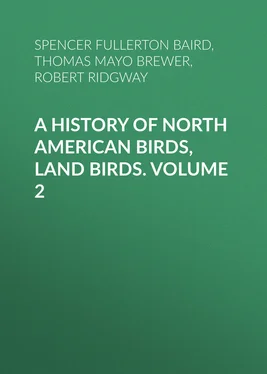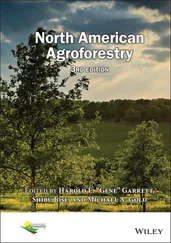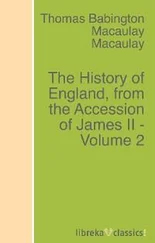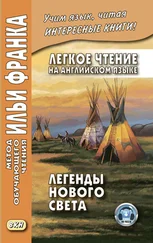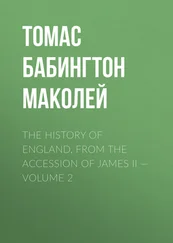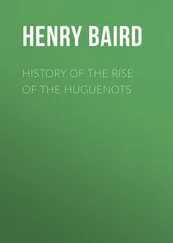Spencer Fullerton Baird - A History of North American Birds, Land Birds. Volume 2
Здесь есть возможность читать онлайн «Spencer Fullerton Baird - A History of North American Birds, Land Birds. Volume 2» — ознакомительный отрывок электронной книги совершенно бесплатно, а после прочтения отрывка купить полную версию. В некоторых случаях можно слушать аудио, скачать через торрент в формате fb2 и присутствует краткое содержание. Жанр: foreign_antique, Биология, foreign_edu, на английском языке. Описание произведения, (предисловие) а так же отзывы посетителей доступны на портале библиотеки ЛибКат.
- Название:A History of North American Birds, Land Birds. Volume 2
- Автор:
- Жанр:
- Год:неизвестен
- ISBN:нет данных
- Рейтинг книги:3 / 5. Голосов: 1
-
Избранное:Добавить в избранное
- Отзывы:
-
Ваша оценка:
- 60
- 1
- 2
- 3
- 4
- 5
A History of North American Birds, Land Birds. Volume 2: краткое содержание, описание и аннотация
Предлагаем к чтению аннотацию, описание, краткое содержание или предисловие (зависит от того, что написал сам автор книги «A History of North American Birds, Land Birds. Volume 2»). Если вы не нашли необходимую информацию о книге — напишите в комментариях, мы постараемся отыскать её.
A History of North American Birds, Land Birds. Volume 2 — читать онлайн ознакомительный отрывок
Ниже представлен текст книги, разбитый по страницам. Система сохранения места последней прочитанной страницы, позволяет с удобством читать онлайн бесплатно книгу «A History of North American Birds, Land Birds. Volume 2», без необходимости каждый раз заново искать на чём Вы остановились. Поставьте закладку, и сможете в любой момент перейти на страницу, на которой закончили чтение.
Интервал:
Закладка:
Mr. Townsend met with this species through several hundred miles of the Platte country in great numbers, as well as on the banks of the Columbia, generally frequenting the low bushes of wormwood ( Artemisia ). It appeared also to be a very pugnacious species. Two of the males were often observed fighting in the air, the beaten party going off crestfallen, and the conqueror repairing to the nearest bush to celebrate his triumph by his lively and triumphant strains. He again met with these birds, though not in abundance, in June, 1825, at the mouth of the Lewis River, on the waters of the Columbia.
This Sparrow was also found very numerous at Sitka, by Mr. Bischoff, but no mention is made of its habits.
Emberiza rufina , “Brandt, Desc. Av. Rossic. 1836, tab. ii, 5 (Sitka),” Bonaparte. Passerella rufina , Bonap. Consp. 1850, 477. (This may refer to Passerella townsendi , but is more probably the present bird.) Melospiza cinerea , Finsch, Abh. Nat. III, 1872, 41 (Sitka). (Not Fringilla c. Gmel.) M. guttata , Finsch, Abh. Nat. III, 1872, 41 (Sitka). (Not Fringilla g. Nutt.)
Sp. Char. Resembling M. guttata in the undefined markings, slender bill, etc., but olivaceous-brownish instead of rufous above, the darker markings sepia-brown instead of castaneous. The white beneath much tinged with ashy; jugulum-spots blended, and of a sepia-brown tint. Wing, 3.00; tail, 3.00; bill .41 from nostril, and .25 deep at base.
Hab. Northwest coast, from British Columbia northward. (Sitka.)
The above characters are those of a large series of specimens from Sitka, and a few points along the coast to the southward and northward, and represent the average features of a race which is intermediate between guttata and insignis , in appearance as well as in habitat. Tracing this variety toward the Columbia River, it gradually passes into the former, and northward into the latter.
We have no distinctive information relative to the habits of this race.
? Fringilla cinerea , Gmelin, I, 1788, 922 (based on Cinereous Finch, Lath. II, 274).—Penn. Arc. Zoöl. II, 68 (Unalaschka). Emberiza cinerea , Bonap. Consp. 1850, 478. Melospiza insignis , Baird, Trans. Chicago Acad. I, ii, 1869, p. 319, pl. xxix, fig. 2.—Dall & Bannister, do. p. 285.—Finsch, Abh. Nat. III, 1872, 44 (Kodiak).
Sp. Char. Summer plumage (52,477 ♂, Kodiak, May 24, 1868). Above brownish-plumbeous, outer surface of wings somewhat more brown, the greater coverts slightly rufescent. Interscapulars with medial broad but obsolete streaks of sepia-brown; crown and upper tail-coverts with more sharply defined and narrower dusky shaft-streaks. Crown without medial light line. Beneath grayish-white, much obscured by brownish-plumbeous laterally. A whitish supraloral space, but no appreciable superciliary stripe; a whitish maxillary stripe; beneath it an irregular one of dusky sepia; irregular streaks of dark grizzly-sepia on breast and along sides, blended into a broad crescent across the jugulum. Wing, 3.30; tail, 3.50; bill, .48 from nostril, .28 deep at base, and .21 in the middle, the middle of the culmen being much depressed, its extremity rather abruptly decurved.
Autumnal plumage (60,162, Kodiak, received from Dr. J. F. Brandt). Differs very remarkably in appearance from the preceding. The pattern of coloration is everywhere plainly plotted, there being a distinct vertical and sharply defined superciliary stripe. Ground-color above ashy, somewhat overlaid by rusty, except on the sides of the neck. Whole crown, outer surface of wings, and dorsal streaks, rusty rufous; black streaks on crown and upper tail-coverts obsolete. Beneath pure white medially, the markings rusty rufous. Wing, 3.30; tail, 3.60; bill, .47 and .30.
Hab. Kodiak and Unalaschka.
This race represents the extreme extent of variation in the species, and it would be difficult for a species to proceed farther from the normal standard; indeed, the present bird is so different even in form, especially of bill, from melodia , that, were it not for the perfect series connecting them, few naturalists would hesitate to place them in different genera.
Habits. No information has so far been published in reference to the nesting of this Sparrow, or of any peculiar habits.
Fringilla lincolni , Aud. Orn. Biog. II, 1834, 539, pl. cxciii.—Nutt. Man. I, (2d ed.,) 1840, 569. Linaria lincolni , Rich. List, 1837. Passerculus lincolni , Bonap. List, 1838. Peucæa lincolni , Aud. Synopsis, 1839, 113.—Ib. Birds Am. III, 1841, 116, pl. clxxvii.—Bonap. Consp. 1850, 481.—Ib. Comptes Rendus, XXVII, 1854, 920. Melospiza lincolni , Baird, Birds N. Am. 1858, 482.—Dall & Bannister, Tr. Ch. Ac. I, 1869, 285 (Alaska).—Cooper, Orn. Cal. 1, 216. Passerculus zonarius , (Bp.) Sclater, Pr. Zoöl. Soc. 1856, 305.
Sp. Char. General aspect above that of M. melodia , but paler and less reddish. Crown dull chestnut, with a median and lateral or superciliary ash-colored stripe; each feather above streaked centrally with black. Back with narrow streaks of black. Beneath white, with a maxillary stripe curving round behind the ear-coverts; a well-defined band across the breast, extending down the sides, and the under tail-coverts, of brownish-yellow. The maxillary stripe margined above and below with lines of black spots and a dusky line behind eye. The throat, upper part of breast, and sides of the body, with streaks of black, smallest in the middle of the former. The pectoral bands are sometimes paler. Bill above dusky; base of lower jaw and legs yellowish. Length, 5.60; wing, 2.60.
Hab. United States from Atlantic to Pacific, north to the Yukon River and the Mackenzie, and south through Mexico to Panama. Oaxaca (Scl. 1858, 303); Xalapa (Scl. 1859, 365); Guatemala (Scl. Ibis, I, 18); Vera Cruz, winter (Sum. M. B. S. I, 552).
There is little or no difference in specimens of this bird from the whole of its range, except that one from near Aspinwall is considerably smaller than usual, the streaks on the back narrower, and the color above more reddish. A young bird from Fort Simpson, on the Mackenzie, is much like the adult.
Habits. Lincoln’s Finch was first met with by Mr. Audubon in Labrador, and named in honor of one of his companions, Mr. Thomas Lincoln, now residing at Dennysville, Maine, by whom the first specimen was procured. His attention was attracted to it by the sweet notes of its song, which, he states, surpass in vigor those of any of our American Sparrows with which he was acquainted. He describes this song as a compound of the notes of a Canary and a Woodlark of Europe. The bird was unusually wild, and was procured with great difficulty. Other specimens, afterwards obtained, did not exhibit the same degree of wildness, and they became more common as the party proceeded farther north. He did not meet with its nest.
He describes the habits of this species as resembling, in some respects, those of the Song Sparrow. It mounts, like that bird, on the topmost twig of some tall shrub to chant for whole hours at a time, or dives into the thickets and hops from branch to branch until it reaches the ground in search of those insects or berries on which it feeds. It moves swiftly away when it discovers an enemy, and, if forced to take to flight, flies low and rapidly to a considerable distance, jerking its tail as it proceeds, and throwing itself into the thickest bush it meets. Mr. Audubon found it mostly near streams, and always in the small valleys guarded from the prevalent cold winds of that country.
Читать дальшеИнтервал:
Закладка:
Похожие книги на «A History of North American Birds, Land Birds. Volume 2»
Представляем Вашему вниманию похожие книги на «A History of North American Birds, Land Birds. Volume 2» списком для выбора. Мы отобрали схожую по названию и смыслу литературу в надежде предоставить читателям больше вариантов отыскать новые, интересные, ещё непрочитанные произведения.
Обсуждение, отзывы о книге «A History of North American Birds, Land Birds. Volume 2» и просто собственные мнения читателей. Оставьте ваши комментарии, напишите, что Вы думаете о произведении, его смысле или главных героях. Укажите что конкретно понравилось, а что нет, и почему Вы так считаете.
